No one says no to speed. People just love speed. The same goes for eCommerce websites as well. When was the last time you waited a while for a website to load? Can’t remember? Don’t worry. You’re not alone.
Most users want websites to load faster so that they can gather information quickly and take necessary actions. So, to create a fast eCommerce website, choosing the right eCommerce platform is essential.
Among other eCommerce platforms, Magento 2 is one of the best. This is because of its drastic performance improvements compared to its previous versions. So, Magento 2 would be ideal for creating a fast eCommerce website.
Now the question is, how do you speed up Magento 2 performance? There are many ways you can speed up Magento 2 performance. But before we get into that, let’s see why it is essential to speed up Magento 2 performance.
Why is It Important to Speed Up Magento 2 Performance?
If your customers lose their patience, waiting for your website to load, they will most likely move on to the next website. With plenty of online options for customers today, there is no good reason why the customer would wait for your website to load.
So it doesn’t matter how good your website is. If it takes time to load, the customer will move on to other websites, resulting in high bounce rates for your website.
That is why it is essential to speed up Magento 2’s performance.
Customers expect a website to be fast and responsive. Sites that take too long to load lead customers to abandon their shopping carts, resulting in lost sales. Slow websites can also adversely affect your search engine rankings.
10 Ways to Speed Up Magento 2 Performance
- Regularly update Magento to the latest version
- Use Varnish cache for Magento caching
- Optimize Images
- Reduce Javascript and CSS
- Use high-performance Magento themes
- Choose extensions carefully
- Use a Content Delivery Network
- Turn on Magento Cache Management
- Select a good Magento server
- Clean Magento logs
1. Regularly Update Magento to the Latest Version
With every new update of Magento, they release new features, bug fixes, and, most importantly, performance and stability improvements. That is why updating Magento 2 is one of the best ways to speed up your Magento 2 performance.
If you’re still stuck with Magento 1, we recommend migrating from Magento 1 to Magento 2. Replatforming can get confusing and tricky. If you do not have an in-house expert, we suggest you get development support to re-platform.
Magento 2 contains a lot of features compared to Magento 1. It provides a seamless customizing experience. On top of that, it also drastically improves the speed and performance of your website.
2. Use a Varnish Cache for Magento caching
While the built-in caching of Magento is good, it doesn’t impress Google regarding its recommendations. That is why Magento 2 supports native Varnish caching.
Varnish caching will drastically improve the speed and performance of your Magento store. Here’s how you configure the varnish cache:
Log in to your admin panel and go to Stores > Configuration > Advanced > System.
Expand the Full Page Cache section and choose Varnish Caching under the Caching Application field.
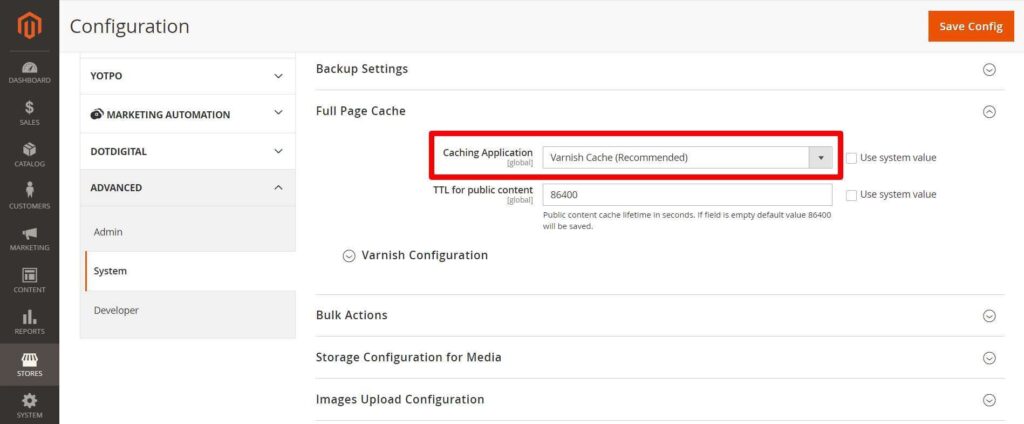
Click on the Save Config button to save the changes.
3. Optimize Images
Being an eCommerce store, there’s no way you can avoid having tons of product images on your store. These images will affect your eCommerce store and slow down your website.
To speed up Magento 2, you need to optimize the images present on your website.
You need to find the right balance between the clarity and size of the images. Usually, reducing the size of the images won’t make much of a difference to the human eye.
You can reduce the size of the images using tools such as Photopea. We also recommend you use JPEG images to speed up Magento 2 store.
4. Reduce Javascript and CSS
Another factor that leads to slow Magento speed is the extensive use of Javascript and CSS.
Reducing and merging the Javascript and CSS files will result in faster page load speeds and better performance.
Magento 2 has a built-in feature to do this. You can minify and merge Javascript and CSS files to speed up Magento 2 performance by following the guidelines below:
- Log in to your admin panel and go to
Stores > Configuration > Advanced > Developer.
- Under the
Javascript Settingssection, assign the valueYesto the following fields:Merge JavaScript FilesEnable JavaScript BundlingMinify JavaScript Files
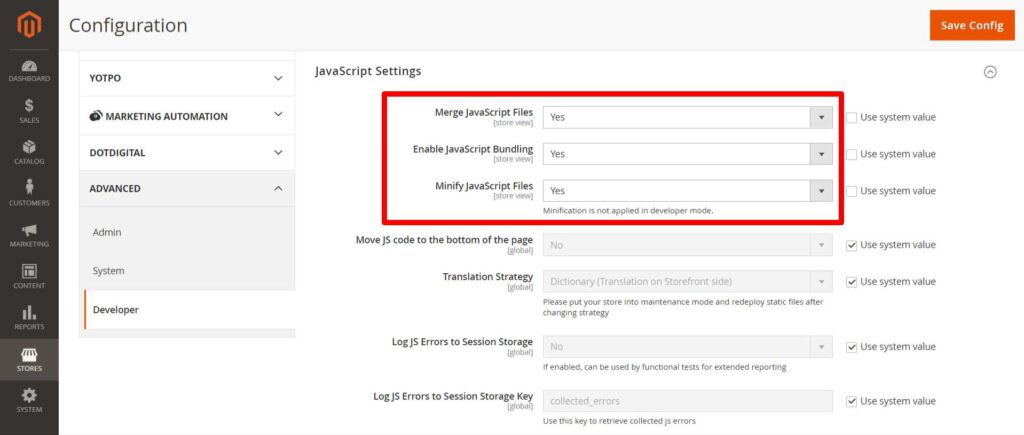
- Next, open the
CSS Settingssection and change the values of the fieldsMerge CSS FilesandMinify CSS FilestoYes.
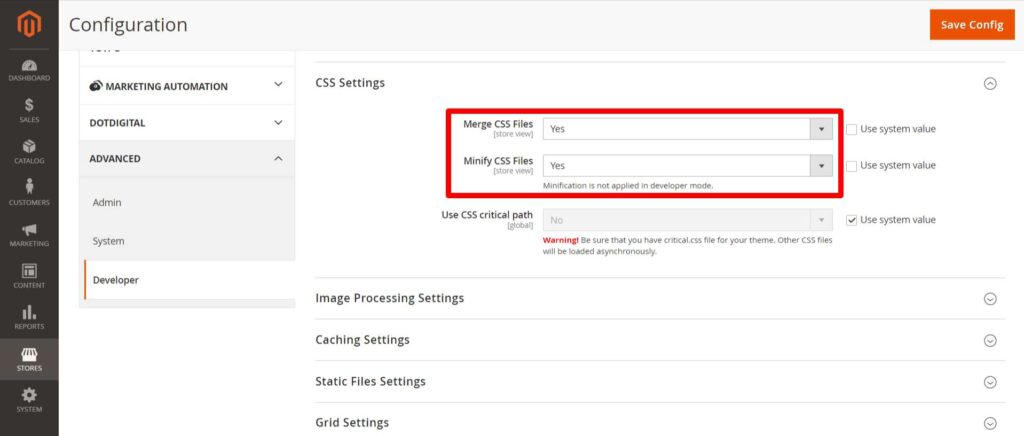
- Finally, click on the Save Config button.
5. Use High-performance Magento Themes
A high-performance theme in Magento 2 helps to improve the overall performance of Magento 2. It does this by reducing the amount of code a browser needs to download when loading a page.
By removing unnecessary elements and code, these themes also reduce the amount of code that needs to be processed server-side. Additionally, a high-performance theme can optimize the delivery of assets such as images, JavaScript, and CSS to improve the loading speed further.
Blazing fast themes help speed up Magento 2 performance by optimizing the website’s loading speed. It does this by reducing the number of HTTP requests, reducing the size of the files, and compressing the images.
It also helps by reducing the number of elements on the page and ensuring that the code is optimized for faster loading.
Finally, a high-performance theme can help reduce the number of plugins and extensions that are used, as well as improve the performance of the website’s caching system.
6. Choose Extensions Carefully
Choosing and installing suitable Magento 2 extensions can be critical to improving the performance of a Magento 2 store. Magento 2 extensions can add functionality to the store and can help to improve the user experience.
However, some extensions can slow down the store’s performance if they are not installed correctly or are not optimized for the store’s particular configuration.
Additionally, some extensions may conflict with existing ones and cause unexpected issues affecting the store’s performance.
By carefully choosing and installing suitable Magento 2 extensions, store owners can ensure that the store is optimized for optimal performance.
Also, inspecting and installing Magento 2 extensions is essential because it helps to ensure that the extensions are compatible with the store, are updated to the latest version, and are optimized for the best performance.
Installing outdated or non-optimized extensions for Magento 2 can lead to slow loading times, errors, and security vulnerabilities.
By inspecting and installing Magento 2 extensions, store owners can help ensure that their store runs at its best.
7. Use a Content Delivery Network
The user experience is negatively impacted by slow loading times, and your website’s SEO suffers. You can drastically increase your website’s speed by setting up your Magento 2 Content Delivery Network (CDN). You must specify and set up your CDN because it is not fully integrated into Magento 2. Here’s how you configure it:
- Log in to your admin panel and go to
Stores > Settings > Configuration > General > Web.
- Expand the
Base URLssection and enter the CDN URL of the static view files in theBase URL for Static View Filesfield.
- In the
Base URL for User Media Filesfield, enter the Javascript file URL on the CDN.
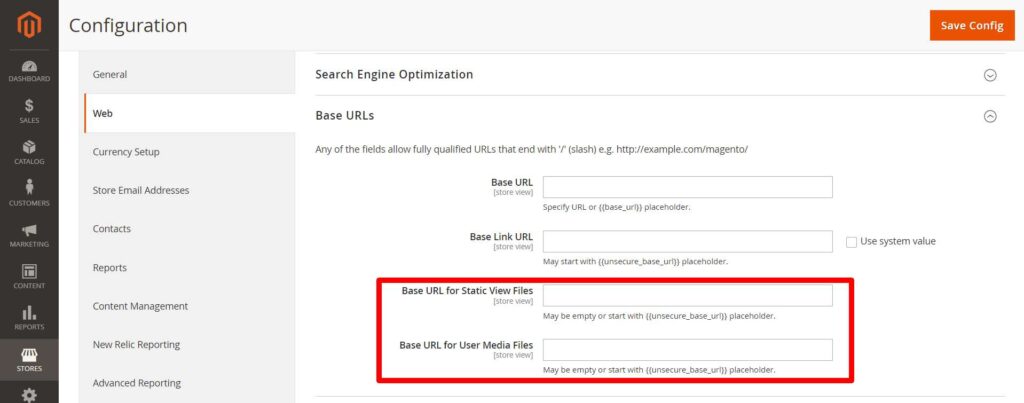
- Now, expand the
Base URLs (Secure)section and enter the CDN URL in theSecure Base URL for Static View Filesfield.
- In the
Secure Base URL for User Media Filesfield, enter the Javascript file URL on the CDN.
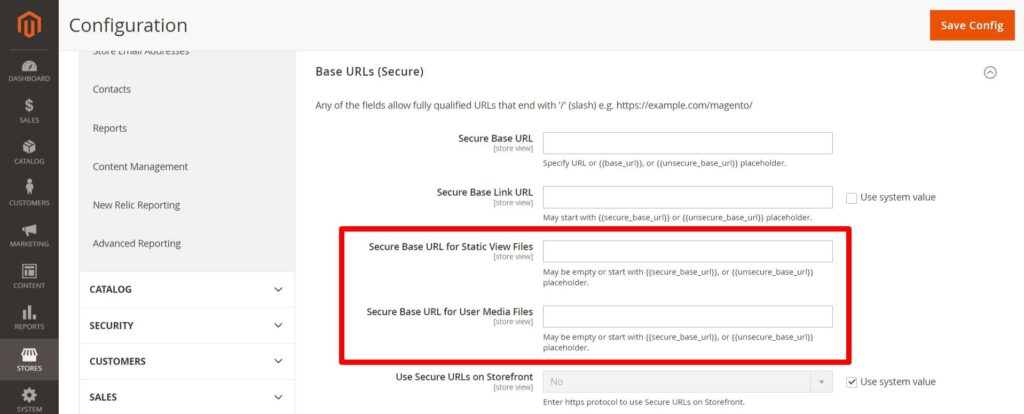
- Finally, click on the Save Config button.
8. Turn on Magento Cache Management
Enabling Magento Cache Management can significantly speed up your Magento store by reducing the resources required to serve requests.
Magento Cache Management stores the results of commonly used operations in memory when enabled. It serves them as static pages, reducing the time it takes to generate dynamic content.
This helps speed up page loading times and reduce server load, resulting in a faster, more efficient Magento store.
Here’s how you enable it:
- Log in to your admin panel and go to
System > Cache Management.
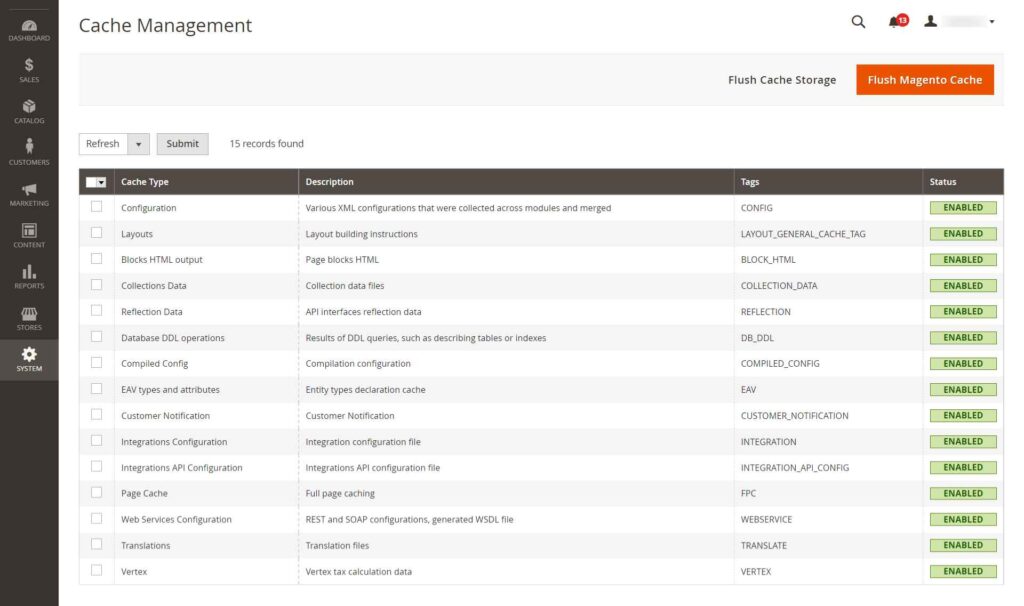
- Select all the fields and click on the Submit button.
- Make sure that the status of all Cache types is green and enabled.
9. Select a Good Magento Server
Selecting a good Magento server will significantly speed up your Magento store by allowing for faster loading times, improved security, and increased scalability. A good Magento server is optimized for the platform to reduce latency and improve performance.
It should also provide a secure and reliable hosting environment for your Magento store.
Additionally, a good Magento server will provide the necessary resources to support the growing needs of a Magento store. By selecting a good Magento server, your store will experience better performance, improved user experience, and smoother operation.
Check out our list of the best Magento hosting providers in 2023.
10. Clean Magento Logs
The database backup and the Magento log slow down your entire Magento store. You can optimize your Magento site by routinely cleaning these logs. This will speed up your Magento store.
Here’s how you clean Magento logs:
- Log in to your admin panel and go to
Stores > Configuration > Advanced > System. - Now, expand the
MySQL Message Queue Cleanupsection. - Under this section, change the values to default or automatic to the following fields:
Successful Messages LifetimeRetry Messages In Progress AfterFailed Messages LifetimeNew Messages Lifetime
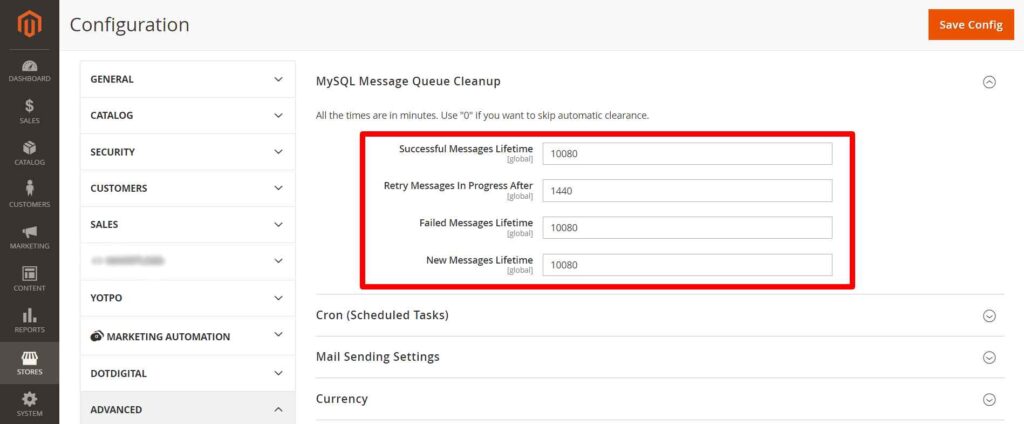
- Finally, click on the Save Config button.
Conclusion
Choosing a great platform like Magento 2 is not just enough. You’ve to optimize to speed up Magento 2’s performance.
We’ve shared some of the best ways to speed up Magento 2’s performance. Following the steps will prevent your website from being slow. This is one of the important metrics used by Google to rank your website.
If you want to check how your website is performing, you can use tools like GTmetrix, to get a detailed performance report of your website. Then, you can work on the areas of improvement to speed up Magento 2 performance.
If you enjoyed reading this article, you should consider going through the following.









